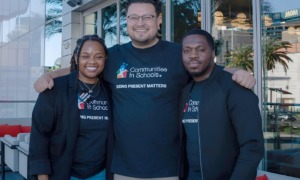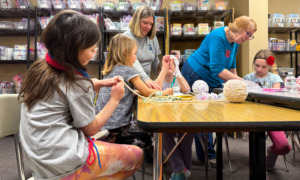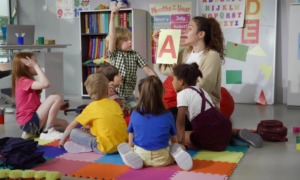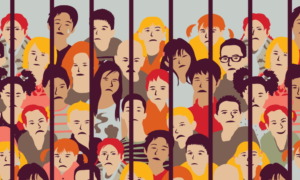Over the next decade, more students with autism spectrum disorders are expected to enroll in America’s universities than ever before. And according to several experts, their success in higher education largely hinges on how institutions accommodate the needs of the ever-increasing population.
Jordan White – a 21-year-old computer science major living in the suburbs of Atlanta – cites a host of revolutionary thinkers as personal influences. Among others, he lists figures such as Abraham Lincoln, Franklin Delano Roosevelt and Thomas Edison as inspirations. Especially important to White is Walt Disney. “Not only was he an innovator, but he was also a great artist,” he said. “I feel like I could be like him someday.” White’s contemporary hero is John Lasseter, chief creative officer for Pixar, whose 1995 film “Toy Story” forever changed White’s life. “Can I do something this innovative when I grow up?” White asked himself after seeing the film for the first time when he was just 4 years old.
White saw the film just a year after being diagnosed with autism. “Obviously, we were shocked,” said David White (pictured left with Jordan), 49, who took his son to in for a screening after Jordan’s paternal grandmother, a first-grade teacher, noted that he hadn’t begun speaking yet. “We very methodically would work with Jordan,” he said, who began undergoing applied behavioral analysis (ABA) therapy shortly after the diagnosis. Following the initial steps of the program, Jordan said his first words right around his fourth birthday. “It’s extremely important to realize that between the ages of three and around five,” David said, “that if you don’t do anything, you can’t mold that brain.”
Jordan said that he didn’t realize he had autism until he was either 10 or 11. “I was like, ‘what is autism?’” he recalled. After begin asked by his father to read up on autism spectrum disorders (ASDs), Jordan said he had to re-evaluate who he thought he was. “I thought I was just a normal kid, like a shy kid,” he said.
In high school, Jordan said his toughest challenge was note taking. He remembered stressing over trying to write down every “single little thing” his instructors said, even though he made high marks in his classes. “I aced the whole thing,” he recollected.
To prepare his son for college, David turned the basement of his home into a makeshift dorm room, eventually moving in as Jordan’s “roommate.” According to Jordan’s father, his son’s transition from high school to college life was “much bigger than we thought it would be.” He said that Jordan would come home from classes and state that “everything’s vague and ambiguous now,” noting that the social transition was much more difficult than the academic one. Jordan began working with his university’s disAbled Student Support Services, which David said was crucial in his son’s early collegiate experiences.
Once considered “unqualified” for post-high school education, increasing numbers of students with autism spectrum disorders are now enrolling in colleges and universities across the United States – with professionals expecting the numbers to continue to drastically increase throughout the decade. While many experts pinpoint legislative changes, such as the 2010 renewal of the Americans with Disabilities Act (ADA), as the primary catalyst for such a seismic increase, others cite policy factors – including inclusive primary education programs and greater incorporation of student disability services at universities – as the most significant factors as to why not only more students with ASDs are entering higher education, but succeeding on an academic level that was once thought impossible.
“Students with autism spectrum disorders are a relatively new phenomenon in higher education,” said Carol Pope, director of disAbled Students Support Services at Kennesaw State University. “I’ve only had students with these disorders for the last, maybe, four or five years.”
Although she said she had observed many students over the years displaying characteristics commonly associated with autism spectrum disorders, it has not been until recently that she’s noticed a massive influx of such students at her university. “The population is just exploding,” she said. “The number of people with diagnoses within that spectrum is just increasing exponentially.”
Nationally, an accurate number of current and prospective college students with ASDs is difficult to obtain – with some experts, including CollegeAutismSpectrum.com co-founder Jane Thierfeld Brown – saying that only about a third of students with spectrum disorders are officially tallied up by the nation’s colleges.
While the Centers for Disease Control (CDC) currently does not have an official estimate regarding the number of college students with autism spectrum disorders, the CDC’s Autism and Developmental Disabilities Monitoring Network estimates that approximately one-in-88 children in the United States has an autism spectrum disorder. Like many experts, Pope said that more and more of these children – in years past, many of whom were stigmatized as “unfit” for higher education – will be enrolling in the nation’s colleges and universities over the ensuing decades.
Pope said that the last five years have been a “learning experience” to figure out how to best accommodate students with ASDs. The challenge, she said, has been centered largely around socialization and behavioral issues, as opposed to in-class performance. “Academically, they’re fine,” she said. The greatest challenge she observes is in how professors and students with ASDs interact, in particular, “getting faculty to buy in and understand and work with and support students within the spectrum when they have behavioral issues.”
Working with faculty, she said, is oftentimes more difficult than working with the students. “They’re first response is usually, ‘nah, this isn’t going to work,’” Pope said. She said that, in many instances, professors “tend to want to exclude rather than figure out ways to make it work.”
Pope said that most students with ASDs required very concrete, very direct in-class instructions, with professors particularly addressing any routine changes – such as lab dates and field trips – very clearly. “They really need that structure,” she said. “They really need that consistency.”
“Now, I’m trying to learn how to study by myself,” Jordan said. “I’m not getting As, I seem to be getting Bs.”
His father quickly chimes in. “Just not all As,” David said, “like he used to in high school.”
Jordan said he has some difficulties in studying “abstract stuff,” which he considers instrumental in developing multimedia and technology applications.
“I often tell people that I’m trying to work as to what I really want to do in my life,” Jordan said. After graduating from his current university, he plans on attending graduate school. He wants to be a “media-maker” once he’s finished with his academic pursuits, perhaps creating “revolutionary computer software” for the animation industry that, in Jordan’s vision, would take the “television and motion picture industry to the next level.”
He wants to start a multimedia production business, most likely in Atlanta. He sees his company growing into a “weirdo, nationwide presence,” potentially even a global outfit.
“I think that might happen when I’m like, 50,” he said.
Earlier this spring, Jordan posted a video on YouTube in which he did an “unboxing” review of several Happy Meal toys from McDonalds. The clip quickly went viral, and many of the responses Jordan received were biting and caustic.
“The Internet is so full of mean people,” Jordan said. The comments caused a great deal of “distress” for him, but he said he wouldn’t let them keep him down.
“It’s more of a psychological concept,” Jordan said regarding his Internet aggressors. “Some people wear different masks. When they’re online, they might end up putting on an ‘I hate you’ mask, and that’s the mask they wear when they try to type stuff in, but in real life, they wouldn’t do that.”
Jordan’s father has seen several of the comments, many of which that focus on his son’s disorder.
“What you have to do is, you just have to ignore it,” David said. “You’ve got to keep doing what you do, understanding what your purpose is in this life, and to not let any comment stop that purpose.”
Jordan has an alternative hypothesis as to why many anonymous Internet users harass him.
“Maybe their life isn’t as, well, excellent as mine,” he proposed.
At 63, Pope has spent almost half of her life working at Kennesaw State University, where she helps coordinate, provide and plan accommodations for students like Jordan. Her job is to ensure that the university complies with federal mandates that provide “equal access” for students with disabilities. Higher education is different from public education, she said, in the sense that colleges and universities do not have the same “mandate for success” that government-funded high schools do.
“We haven’t had these students long enough to establish standards,” Pope said. Many times, she works with students with ASDs prior to their registration, and observes that almost always, their success in higher education has to be taken on a “student-by-student” basis.
“The biggest issue for us recently in higher education have been the changes to the ADA (Americans with Disabilities Act),” she said. “What it has done is significantly expand the definition of disability and significantly reduce what we can require as far as information and documentation in order to qualify a student.”
As a result, Pope has observed both a massive upswing in the number of students at her university qualifying for accommodations, as well as a broader variety of disorders among the student body itself.
“If there is any evidence at all that any disorder is, in someway, interfering with a student’s participation in school, then they are qualified for accommodations,” she said.
The changes to the ADA, which was reauthorized in 2010, prohibits her from asking students several question pertaining to disorders and disabilities. “I can’t ask for as much information now as I used to,” she said. Much of that information, she adds, was vital in determining which strategy worked best for students requiring special accommodations.
“We’re going to get more and more and more of these students,” she said. “The numbers are only going to go up, and we’ve got to be more open and accommodating.”
She said that there is a great need to educate staff and faculty, specifically in getting them to be more inclusive regarding students with ASDs.
“We’ve got to be more willing to work with that group,” she said, “because they’re coming.”
Through the services provided by his university, Jordan has been linked up with a psychologist, a dietician and even a personal trainer. He’s allowed to take his tests at the student disability center, where he will not be distracted by other students. In one of his communication classes, he said he learned about “object adapters” – physical “motivators” like pacing and tapping one’s fingers – that helped him focus while doing his homework.
“Autistic people should make use of object adapters because it might help them to study,” he said. He also suggests that fellow students having something around to calm them down. For Jordan, it’s a miniature plastic ball pit – not unlike the kind found at fast food restaurant playgrounds – he had installed in his bedroom. When stressed out, he said he likes to lay in it, as he finds the full-sensorial experience comforting and relaxing.
“Just because someone is socially awkward does not mean they are not an intelligent person, a caring person and someone who has emotions,” Jordan’s father said. He believes that parents of autistic children should make an effort to place their sons and daughters in “regular” classrooms as opposed to specialized courses.
“Stay focused, stay determined and understand what laws are out there that push inclusion in the early grades,” he said. Since he was five, Jordan has been enrolled in “normal” classes, which his father believes made a “tremendous difference” in his son’s ability to collect social behaviors.
“The treasure this country has in high functioning autistic people is not being mined properly,” David said. “These people have a tremendous amount to offer our country, our communities and our employers, and anything we can do to help parents to enable their children [would be] beneficial for society.”
Jordan said that, like most college students, he tends to goof off from time to time. “I pray to God, each and every night, that He will help me truly learn how to learn,” he continued. He realizes the importance of “applying bits of knowledge to other bits of knowledge,” and offered his advice to prospective college students with autism spectrum disorders.
“Don’t get so distressed,” he concluded. “I would say, ‘hey, guys, how about you keep on studying?’”































